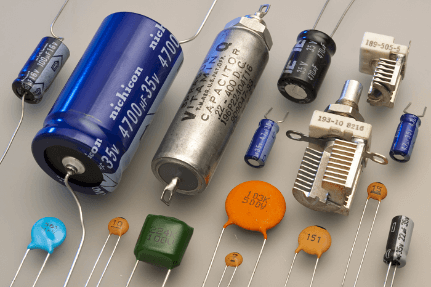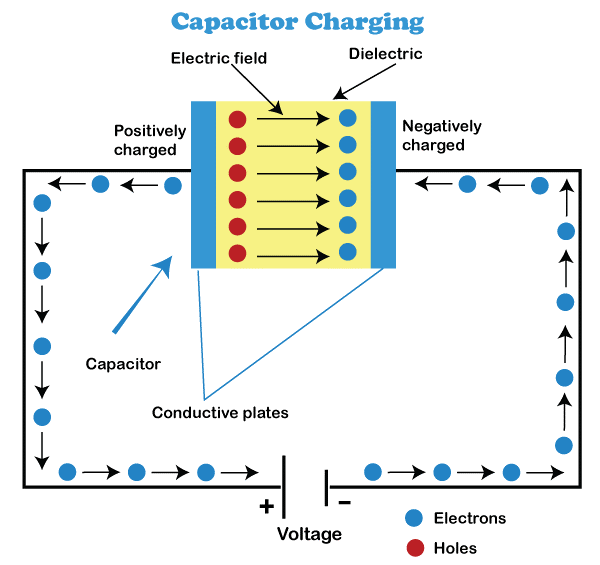Capacitors DefinitionAn electronic component which shows electrostatic energy in an electric field is known as a capacitor. It looks like a battery but has distinct working as a battery converts chemical energy into mechanical energy. Capacitor stores energy in the form of electric charge. This electrical device has two terminals known as conductors. Distance between the charges decreases the force between them, whereas charge values increase the force. Insulating material, known as a dielectric, is used to create the distance between these conductors. The potential to store charges in the capacitor is known as its Capacitance. There comes the point in the capacitor when it carries charges more than its potential or Capacitance with respect to voltage. This period of time is known as the charging time of the capacitor. 
Working of the capacitor
Determining the values of the capacitorCharges (Q+ or Q-) on the conducting plates create the electric field between the plates. Also, potential difference and electric field are directly proportionate to each other. The capacitor is also referred to as the change in the ratio between the electric charge and the change in the electric potential. The Capacitance of a capacitor depends upon its usage. It can be fixed and variable as well. The Capacitance depends on the capacitor's shape and size and the insulator used between the conducting plates, i.e., positive and negative plates. How is energy stored in the capacitor?Charges are put in use by letting them flow towards each other in a circuit when opposite charges are placed parallel to each other in a capacitor. U = ( CV )( CV ) / 2 Capacitors are like rechargeable batteries. There exist some differences between the working of capacitors and batteries, due to which they are different from each other. Capacitor does not gain energy from chemical reaction like batteries do. Difference between the capacitor and batteryBoth capacitors and batteries are made to deliver for the same motive but still carry some significant differences which are given below:
Standard units of CapacitanceFarad is the standard unit of Capacitance but is relatively large for practical situations. Therefore, microfarads and picofarads are the subunits of farads to be used as measures.
Different types of capacitorsCapacitors are available in different shapes and sizes. The most common capacitors are ceramic capacitors, super capacitors and electrolytic capacitors. Ceramic capacitors- These capacitors carry relatively small charges and leak less current. They are also the cheapest capacitors. These capacitors are easily identifiable by the small bulbs, either in red or yellow colour. Electrolytic capacitors- These capacitors look the same as the small tin cans on a circuit board. However, they are small in size but carry a good amount of charge and leak current very easily and quickly when compared to that ceramic ones. These capacitors perform their function when they are wired in a specific orientation. The positive pin on the capacitor is known as the anode, and the negative pin is known as the cathode. The positive side, i.e., the anode, is connected to the side to get a higher voltage. As they easily discharge current, that is why they are not considered the best option to store energy. Super capacitors- These are used to store a good amount of energy. They can hold more voltage. These capacitors can discharge all their charges easily. How to choose the best capacitor?Keep in mind the following attributes by choosing the capacitors :
Next TopicCapital Definition
|
 For Videos Join Our Youtube Channel: Join Now
For Videos Join Our Youtube Channel: Join Now
Feedback
- Send your Feedback to [email protected]
Help Others, Please Share










